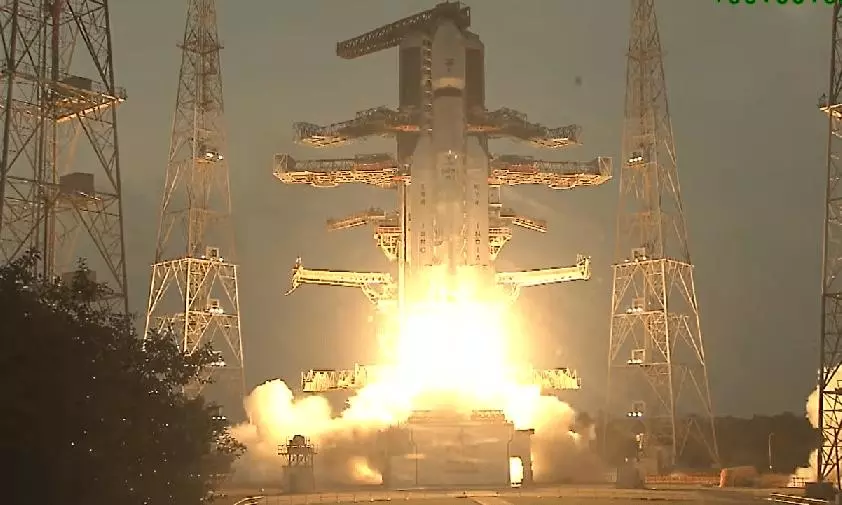
In rare feat, ISRO’s ‘Bahubali’ injects heaviest satellite into orbit
ISRO says 4,410-kg CMS-03 is a multi-band communication satellite that will provide services over a wide oceanic region, including the Indian landmass

In a rare feat, ISRO’s heaviest communication satellite, CMS-03, launched from the space station in Sriharikota aboard the home-grown 'Bahubali' rocket, was successfully placed into the intended orbit on Sunday (November 2).
CMS-03, weighing 4,410 kg, was flown on a LVM3-M5 rocket, enabling the Indian space agency to accomplish this feat. CMS-03 is a multi-band communication satellite and would provide services over a wide oceanic region, including the Indian landmass, ISRO has said.
Also read: Why Oct 4-10 is celebrated as World Space Week; how India celebrates it
The satellite was placed in the desired Geosynchronous Transfer Orbit (GTO).
It is also a replacement for the GSAT 7 series, launched in 2013.
Yet another pride: ISRO director
ISRO Chairman V Narayanan said the launch vehicle successfully injected the communication satellite in the required orbit.
The "4410 kg satellite is precisely injected," he said. In his address from the Mission Control Center post-launch, he described the LVM 3 satellite as 'Bahubali,' in an apparent reference to its heavy-lift capability.
He recalled that the rocket's previous launch was the "most prestigious Chandrayaan 3, which brought pride to the nation." It achieved "yet another pride" on Sunday after succeeding with the "heavier satellite." All eight LVM 3 launches, including its experimental mission, have been successful, showing a 100 per cent success rate.
Also read: India to develop 'bodyguard satellites' after orbital near-miss: Report
‘Scientists braved challenges’
The satellite was designed to provide communication services for at least 15 years and is "yet another shining example of Atmanirbhar Bharat" (self-reliant India)," Narayanan, also Secretary, Department of Space, added.
The ISRO scientists had a tough time with the mission since the weather was not cooperative, but they worked hard and ensured success, he said.
Prior to Sunday's launch, the Indian space agency has been utilising the services of the Kourou launch base in French Guiana by Ariane rockets offered by France-based Arianespace, for launching heavier satellites.
On December 5, 2018, ISRO launched its heaviest communication satellite, GSAT-11, weighing 5,854 kg, onboard an Ariane-5 VA-246 rocket from French Guiana.
Also read: India-US space partnership expands from satellites to Moon, Mars
Self-reliance in ‘heavier’ missions
LVM3-M5, a three-stage launch vehicle with two solid motor strap-ons (S200), a liquid propellant core stage (L110), and a cryogenic stage (C25), gives ISRO full self-reliance in launching heavier communication satellites that weigh up to 4,000 kg in GTO.
LVM3 is also termed by ISRO scientists as Geosynchronous Satellite Launch Vehicle (GSLV) MkIII.
Scientists at ISRO have classified launch vehicles depending upon the mission objectives, targeted orbit, and altitude among others.
The launch vehicles or launchers used by ISRO include Polar Satellite Launch Vehicle (PSLV), GSLV and LVM3 (Launch Vehicle Mark-III). The space agency has been providing launch services for customer satellites since 1999 from Sriharikota.
Bahubali’s significance
As regards to Sunday's mission, the LVM3 rocket holds significance as it has successfully launched a heavier communication satellite from Indian soil. The LVM3-M5 is the fifth operational flight, ISRO said.
The LVM3 vehicle was developed with completely indigenous technology, including the C25 cryogenic stage. It has a track record of all successful launches, from the first development flight LVM-3 Crew module Atmospheric Re-entry Experiment (CARE) launched in December 2014, ISRO said.
Also read: ISRO conducts first air-drop test for Gaganyaan mission
For the ambitious Gaganyaan Mission, ISRO had planned the human-rated LVM3 rocket as the launch vehicle, which is named as HRLV, ISRO said.
This LVM3 rocket is capable to carry payload to GTO weighing 4,000 kg and for Low Earth Orbit, payloads of 8,000 kg with its powerful cryogenic stage. The two S200 solid rocket boosters located on the sides of the rocket provide the thrust required for lift off. The S200 boosters are developed at Vikram Sarabhai Space Centre, Thiruvananthapuram.
The third stage is the L110 Liquid Stage and is powered by two Vikas engines designed and developed at the Liquid Propulsion Systems Centre.
The previous mission of the LVM-3 rocket was the successful launch of the Chandrayaan-3 mission, wherein India became the first country to land successfully near the lunar South pole in 2023. The satellite weighed 3841.4 kg.
(With inputs from agencies)
Live Updates
- 2 Nov 2025 5:57 PM IST
Important experiment
For the first time we have successfully ignited the thrust chamber. This will help in re-igniting the cryogenic stage in future missions: Narayanan
- 2 Nov 2025 5:54 PM IST
We had a challenging time during the launch: ISRO director
"Despite challenges, we could accomplish the mission in a grand manner," says Narayanan.
- 2 Nov 2025 5:51 PM IST
Today’s mission brings yet another glory to India: ISRO director
ISRO Director Dr V Narayanan congratulates ISRO community, all scientists and people associated with the project.
- 2 Nov 2025 5:47 PM IST
CMS-03 successfully placed in intended orbit
CMS-03 was separated and successfully injected into orbit.
- 2 Nov 2025 5:37 PM IST
Cryogenic stage is normal
The rocket has successfully crossed the first two stages on its way to orbit
- 2 Nov 2025 5:28 PM IST
LVM3 lifts off
ISRO has successfully launched the LVM3-M5 carrying CMS-03 communication satellite to space.
- 2 Nov 2025 5:11 PM IST
Mission director authorises automatic launch sequence
It is authorised 14 mins 30 seconds ahead of the launch.


